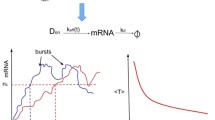Abstract
The path-preference traffic flow cellular automaton is suggested to model the dynamics of transcription. The main difference from the simple traffic flow model is that it contains another preferential paths at some sites. In this paper, we propose an exact analysis for the simplest version of this model. We find that the density of particles is dominant to the dynamics of this cellular automaton and observed that there are not only expected phase shift but also several gaps as the density increases. By considering the behavior of periodic orbits, we also determine the point where such gaps in the flow appear and the exact value of the flow.





















Similar content being viewed by others
References
Wolfram, S.: A New Kind of Science. Wolfram Media, Champaign (2002)
Belitsky, V., Ferrari, P.A.: Ballistic annihilation and deterministic surface growth. J. Stat. Phys. 80, 517 (1995)
Macdonald, C., Gibbs, J., Pipkin, A.: Kinetics of biopolymerization on nucleic acid templates. Biopolymers 6, 1 (1968)
Derrida, B.: An exactly soluble non-equilibrium system: the asymmetric simple exclusion process. Phys. Rep. 301, 65 (1998)
Tokihiro, T., Takahashi, D., Matsukidaira, J., Satsuma, J.: From soliton equations to integrable cellular automata through a limiting procedure. Phys. Rev. Lett. 76, 3247–3250 (1996)
Schadschneider, A., Schreckenberg, M.: Cellular automation models and traffic flow. J. Phys. A: Math Gen. 26, L679 (1993)
Ohta, Y., Nishiyama, A., et al.: Path-preference cellular-automaton model for traffic flow through transit points and its application to the transcription process in human cells. Phys. Rev. E 86, 021918 (2012)
Cook, P.R.: Principles of Nuclear Structure and Function. Wiley-Liss, New York (2001)
Papantonis, A., Larkin, J.D., Wada, Y., Ohta, Y., Ihara, S., Kodama, T., Cook, P.R.: Active RNA polymerases: mobile or immobile molecular machines? PLoS Biol. 8, e1000419 (2010)
Fraser, P., Bickmore, W.: Nuclear organization of the genome and the potential for gene regulation. Nature (London) 447, 413 (2007)
Ohta, Y., Kodama, T., Ihara, S.: Cellular-automaton model of the cooperative dynamics of RNA polymerase II during transcription in human cells. Phys. Rev. E 84, 041922 (2011)
Tripathi, T., Chowdhury, D.: Interacting RNA polymerase motors on a DNA track: Effects of traffic congestion and intrinsic noise on RNA synthesis. Phys. Rev. E 77, 011921 (2008)
Tripathi, T., Schüz, G.M., Chowdhury, D.: RNA polymerase motors: dwell time distribution, velocity and dynamical phases. J. Stat. Mech: Theor. Exper. P08018 (2009)
Brankov, J.G., Pesheva, N.C., Bunzarova, N.Zh.: arXiv:0803.2625
Negami, H.: Private communication
Tannai, T., Nishinari, K.: Propagation of Congestion in TASEP Network. J. Cell. Autom. 11, 363–375 (2016)
Acknowledgements
We would like to thank Professors Tetsuji Tokihiro and Youichiro Wada for helpful comments. This research is supported by Platform for Dynamic Approaches to Living System (the Platform Project for Supporting in Drug Discovery and Life Science Research) from the Ministry of Education, Culture, Sports, Science (MEXT) and Technology, Japan, and Japan Agency for Medical Research and Development (AMED). This work is also partially supported by the JPSJ KAKENHI Grant Number 17K14199.
Author information
Authors and Affiliations
Corresponding author
About this article
Cite this article
Nakata, Y., Ohta, Y. & Ihara, S. Periodic orbit analysis for the deterministic path-preference traffic flow cellular automaton. Japan J. Indust. Appl. Math. 36, 25–51 (2019). https://doi.org/10.1007/s13160-018-0328-6
Received:
Revised:
Published:
Issue Date:
DOI: https://doi.org/10.1007/s13160-018-0328-6




